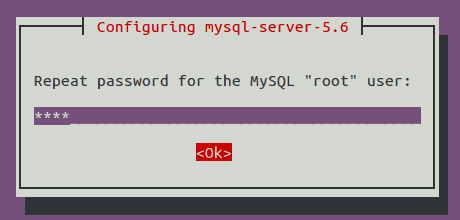Last Updated on 11/11/2020

This tutotial will show in a few steps, how to install MySQL Server 5.6 on Ubuntu.
Installation
Run the above command on your terminal:
sudo apt-get install mysql-server-5.6
You may be asked to install extra packages, type y to confirm:
Reading package lists... Done Building dependency tree Reading state information... Done The following extra packages will be installed: libaio1 libdbd-mysql-perl libdbi-perl libhtml-template-perl libmysqlclient18 libterm-readkey-perl mysql-client-5.6 mysql-client-core-5.6 mysql-common mysql-common-5.6 mysql-server-core-5.6 Suggested packages: libclone-perl libmldbm-perl libnet-daemon-perl libplrpc-perl libsql-statement-perl libipc-sharedcache-perl mailx tinyca The following NEW packages will be installed: libaio1 libdbd-mysql-perl libdbi-perl libhtml-template-perl libmysqlclient18 libterm-readkey-perl mysql-client-5.6 mysql-client-core-5.6 mysql-common mysql-common-5.6 mysql-server-5.6 mysql-server-core-5.6 0 upgraded, 12 newly installed, 0 to remove and 99 not upgraded. Need to get 609 kB/21.5 MB of archives. After this operation, 165 MB of additional disk space will be used. Do you want to continue? [Y/n] y
Then, you will be prompted to type a password for the root user:

Confirm your password:

Well done! By intalling MySQL from the above steps, all the settings needed to auto initialize your server at system startup are already set.
Testing your database
Still on terminal, let’s connect to MySQL using the root user and the password we defined in the earlier steps:
mysql -u root -p Enter password:
Then, you will be presented with the welcome message of MySQL Server:
Welcome to the MySQL monitor. Commands end with ; or \g. Your MySQL connection id is 44 Server version: 5.6.19-0ubuntu0.14.04.1 (Ubuntu) Copyright (c) 2000, 2014, Oracle and/or its affiliates. All rights reserved. Oracle is a registered trademark of Oracle Corporation and/or its affiliates. Other names may be trademarks of their respective owners. Type 'help;' or '\h' for help. Type '\c' to clear the current input statement. mysql>
Let’s do our first query to make sure that everything worked as expected:
mysql> select version(); +-------------------------+ | version() | +-------------------------+ | 5.6.19-0ubuntu0.14.04.1 | +-------------------------+ 1 row in set (0.00 sec)
Hope it helps. Cya!
Pingback: Install MySQL Workbench on Ubuntu - bgasparotto